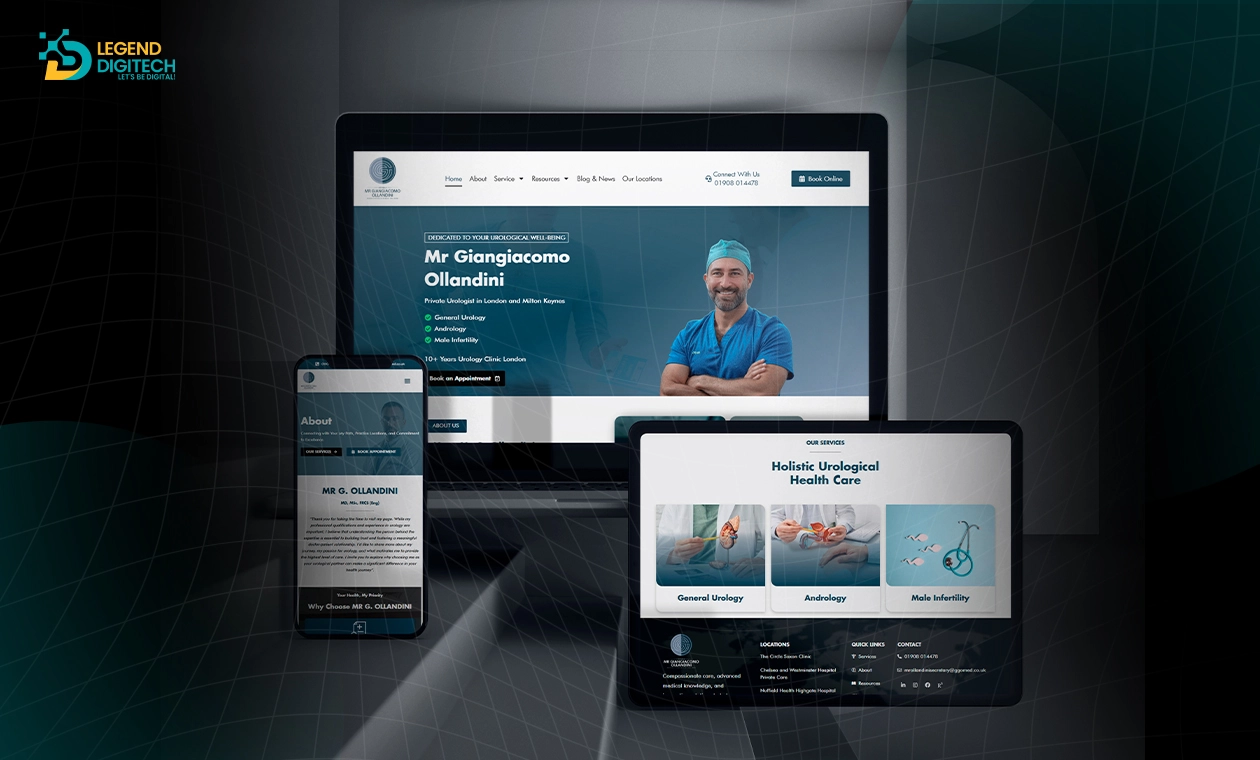Contents
A well-crafted healthcare marketing plan can give your healthcare practice a waiting room full of patients. Sounds like a witty claim? It is not far-fetched. A strategic healthcare marketing plan is much more than mere chance. It assures your patients discover, trust, and ultimately select your services.
In the competitive UK healthcare market, only those practices that follow a full-fledged marketing plan stand out. Because healthcare now demands much more than clinical excellence. It requires building a strong reputation and delivering impactful, quality care.
This guide will cover the fundamentals of healthcare marketing.
Let’s get started — your patients are waiting!
Importance of Healthcare Marketing in the Digital Age
The healthcare landscape is evolving — fast.
Today, patients know a lot. They search their symptoms online, read reviews, and check websites before picking a doctor, just like online shoppers. According to a study conducted in Belgium, most patients refer to ‘Dr Google’ before consulting a GP.
Also, more telehealth, online visits, and personal care mean patients want a great care experience. They expect good service from their healthcare provider.

Benefits of a Strong Marketing Plan
A good healthcare marketing plan can help your practice succeed by:
Setting SMART Goals for Your Healthcare Practice
A well-defined marketing plan starts with clear, actionable goals. The SMART framework—Specific, Measurable, Achievable, Relevant, and Time-bound—helps guide your efforts, ensuring every marketing initiative has a purpose and measurable outcome.
A. Specific Goals
Avoid vague objectives like “increase patient visits” or “improve online presence.” Instead, define precise goals such as:
B. Measurable Progress
Use key performance indicators (KPIs) to track your success. Metrics to monitor include:
C. Achievable Targets
Set realistic goals based on your resources, market conditions, and past performance. For example:
- If you currently get 200 website visits per month, aim for a 20% increase rather than doubling it overnight.
- If you receive 10 new patient inquiries weekly, increasing to 15 is an attainable short-term goal.
D. Relevant to Your Practice
To make sure your goals align with your vision, ask yourself:
E. Time-Bound Objectives
Every goal should have a deadline to track progress. Examples include:
Branding and Value Proposition Development
Strong branding is crucial for standing out in a competitive healthcare market. It shapes how patients perceive your practice, builds trust, and fosters loyalty. Your brand isn’t just about a logo or a color scheme; it’s the promise you make to your patients and the experience they can expect when interacting with your practice. Developing a solid value proposition is key to defining this promise.
A. Defining Your Brand
To create a memorable and recognisable brand, start by clearly defining what your practice stands for:
- Your Mission and Vision: What is the core purpose of your practice? Are you focused on compassionate care, innovative treatments, or patient education? Your mission and vision should resonate with your target audience and be reflected in all your messaging.
- Brand Personality: How do you want your practice to be perceived? Is it modern and tech-forward, or traditional and community-oriented? Your brand personality influences your tone of voice, patient interactions, and overall image.
B. Creating a Value Proposition
Your value proposition is a concise statement that answers the question, “Why should patients choose your practice?” It should address the specific needs and desires of your target market whilst clearly differentiating you from your competitors. Your value proposition should:
- Identify patient pain points and demonstrate how your services provide solutions.
- Highlight unique benefits that other practices do not offer. This could be specialised services, extended hours, telehealth options, or personalised care.
- Be patient-centered, focusing on the benefits patients will experience, such as better health outcomes, convenience, or a more supportive experience.
For example, if your practice specialises in urgent care, your value proposition could be: “Providing quick, reliable care when you need it most—without the long wait times.”
C. Consistency Across All Touchpoints
Your branding and value proposition should be reflected consistently across all marketing channels. This consistency builds recognition and trust. Ensure that:
- Visual identity (logo, colors, website design) is uniform across your website, social media, print materials, and signage.
- Messaging stays aligned with your value proposition in emails, blog posts, patient interactions, and advertising campaigns.
- Patient experience meets the expectations set by your brand. From the moment a patient calls to schedule an appointment to the care they receive during their visit, every touchpoint should reflect your brand values.
D. Building Brand Recognition
Brand recognition is achieved over time through consistent effort. The more patients see and interact with your brand, the more likely they are to remember it when the need arises. To build brand recognition:
- Use social media to engage with your audience regularly. Post valuable content that reinforces your brand’s personality and value.
- Participate in community events and sponsorships to increase your visibility in the local area.
- Encourage patient referrals and positive reviews to leverage word-of-mouth marketing, which is incredibly powerful in healthcare.
Developing a strong brand and a clear value proposition creates a lasting impression and helps you maintain a competitive edge in your market. It encourages patients to not only choose your practice but also become loyal advocates who will return and recommend your services to others.
Healthcare Marketing Techniques: Digital and Traditional Approaches
In today’s fast-paced world, patients are looking for healthcare providers who can meet them where they are. Whether that’s online or in their local community. That’s why blending digital and traditional marketing techniques is key to crafting an effective strategy that gets results.
By using both approaches, you can expand your reach, build stronger patient relationships, and drive real business growth.
A. SEO and Website Optimisation
Your website is often the first impression patients will have of your practice – so let’s make it count! SEO (Search Engine Optimisation) will make sure your website shows up when potential patients search for healthcare services in your area.
Here’s how to kickstart your SEO strategy:
Local SEO
People often search for services nearby, so optimise your site with location-based keywords like “best healthcare practice in [city]” or “top healthcare services near me.” Don’t forget to claim your Google My Business listing and add your practice to online directories to boost visibility.
Content is King
Keep your website fresh with helpful, informative content like blog posts, FAQs, and service descriptions. Regularly updating your site not only improves your SEO but also provides valuable information to prospective patients who are looking for solutions.
Mobile Optimisation
With so many patients searching for care on their smartphones, your website needs to be mobile-friendly. A smooth, responsive experience ensures your visitors stay engaged and helps you rank higher in search results.
B. Social Media and Content Marketing
Social media is more than just posting pretty pictures – it’s about creating a space for meaningful interaction and engagement with your community. Platforms like Facebook, Instagram, LinkedIn, and Twitter are perfect for sharing valuable content and building relationships with current and potential patients:
Educate and Inspire
Share insightful health tips, success stories, and expert advice to establish your practice as a trusted source of knowledge. Whether it’s a post about managing stress or a success story from a happy patient, your followers will appreciate content that adds value to their lives.
Get Social
Engage with your followers! Respond to comments, answer questions, and create interactive posts that spark conversations. Building relationships online helps patients feel more connected to your practice.
Visual Content that Pops
Use photos and videos to showcase the heart of your practice. Show behind-the-scenes moments, introduce staff, and host live Q&A sessions. People connect more deeply with faces and stories – so don’t be afraid to let your personality shine through!
Another great way to keep your website engaging is by posting valuable blog content. Write articles that answer common questions, provide health tips, and offer step-by-step guides on how patients can take care of their health. This kind of content is not only useful but also helps build credibility with your audience.
C. Email Marketing and Patient Engagement
Emails are a fantastic way to stay in touch with your patients and keep them engaged with your practice. By sending out thoughtful, timely, and personalised messages, you can build trust and keep patients coming back:
Appointment Reminders
Sending friendly reminders for upcoming appointments can reduce no-shows and ensure your practice runs smoothly. Plus, patients will appreciate the thoughtful reminder!
Health Tips & Newsletters
Regularly send newsletters with valuable health tips, seasonal advice, or even fun facts. Keeping your patients informed helps establish your practice as their go-to resource for health information.
Exclusive Offers and Updates
Don’t forget to send out exclusive offers, promotions, or news about new treatments. Everyone loves a little special treatment, and it’s a great way to keep patients excited about your practice.
Patient Feedback
Ask your patients for feedback and reviews. Send surveys or encourage them to leave a review on Google or social media. Feedback not only helps you improve, but it shows your patients that you genuinely care about their experience.
D. Traditional Marketing Strategies
Whilst digital marketing is essential, traditional marketing techniques are still an important part of the mix. These approaches can help you establish a strong presence in your community and build face-to-face connections that digital marketing alone can’t always provide:
Print Advertising
Sometimes, old-school methods work best. Flyers, brochures, and posters placed in strategic locations – like local businesses, libraries, or health clubs – can still help you reach a broader audience.
Community Engagement
Attend local health fairs, wellness expos, or charity events. When you show up in person, it helps you build trust and create meaningful relationships with local patients. Plus, it’s a great opportunity to network with other healthcare providers.
Referral Partnerships
Partnering with other local healthcare professionals, such as specialists, therapists, and family physicians, can be a powerful way to generate new patient referrals. A trusted recommendation can go a long way in building credibility.
Direct Mail Campaigns
Don’t overlook the power of direct mail! Sending postcards, newsletters, or health tips directly to your community’s mailbox keeps your practice top-of-mind. Plus, it adds a personal touch that digital messages can’t replicate.
Budgeting for Your Healthcare Marketing Plan
You need a solid plan for how you’ll spend money on your healthcare marketing and advertising to make sure you’re getting the most out of it. First, think about what you want to achieve. Do you want more new patients? Do you want to keep your current patients happy? Your goals will help you decide where to put your money.
Start by looking at your different marketing options.
- How much will it cost to run ads on Google?
- What about social media ads?
- How much will you spend on printing flyers or hosting events?
Write down all the costs, so you have a clear picture. Then, decide how much you can afford to spend overall.
Don’t spend more than you have. It’s better to start small and see what works, then increase your budget later.
Here are some tips for budgeting:
- Allocate based on goals: If you want to get more patients from online searches, put more money into SEO and Google Ads. If you want to reach people in your local area, spend more on flyers and local events.
- Track your spending: Use a spreadsheet or a tool to keep track of how much you’re spending on each marketing activity. This helps you see where your money is going.
- Look at your ROI: ROI means “return on investment.” It’s how much money you get back for every dollar you spend. See which marketing activities are bringing in the most patients and focus on those.
- Be flexible: Your budget might need to change as you learn what works best. Be ready to adjust things as you go.
- Use free tools: Some online tools can help you with marketing, and they don’t cost anything. For example, Google Analytics can help you see how many people visit your website.
Don’t be afraid to try different things. Marketing is about experimenting and finding what works best for your practice. By budgeting carefully and tracking your results, you’ll see a better return on your investment and get more patients.
Tracking, Analysing, and Optimising
You’re putting time and money into marketing, so you need to know if it’s working. That’s where tracking and analysing come in. It’s like checking the engine of a car – you want to make sure it’s running smoothly.
Here’s how you can do it:
Use Tools to See What's Happening
- Google Analytics: This tool tells you how many people visit your website, what pages they look at, and where they come from. It helps you see if your website is bringing in patients.
- Social Media Analytics: Facebook, Instagram, and other platforms have tools that show you how many people see your posts, like them, and share them. This helps you see if your social media is working.
- CRM (Customer Relationship Management) Software: This helps you track leads and patients. You can see how many people contact you through your website or ads, and how many become patients.
Looking at the Numbers
- Website Traffic: How many people are visiting your website?
- Conversion Rate: How many people who visit your website become patients?
- Social Media Engagement: How many likes, comments, and shares you get on your posts.
- Patient Acquisition Cost: How much money you spend to get one new patient.
- Patient Retention rate: How many patients come back for future appointments.
Asking for Feedback
- Send surveys to patients to ask them what they think about your services and your marketing.
- Read reviews online and see what people are saying about your practice.
- Talk to your staff and see what they hear from patients.
Make Changes Based on What You Learn
- If your website isn’t bringing in many patients, try changing the design or adding more helpful information.
- If your social media posts aren’t getting much engagement, try posting different types of content or posting at different times.
- If patients complain about long wait times, try to find ways to improve your scheduling.
Keep Trying New Things
- Marketing is always changing. Don’t be afraid to try new strategies and see what works.
- Keep up with the latest trends in healthcare marketing.
- Never stop learning and improving your techniques.
Healthcare Marketing Plan Example (Downloadable Resource)
FAQs on Healthcare Marketing Strategies
Why is a healthcare marketing plan important?
A healthcare marketing plan helps you attract new patients, retain existing ones, and build a strong reputation. A good plan ensures your practice remains competitive and visible in a crowded market.
How much should I budget for healthcare marketing?
Your budget depends on your practice size, goals, and market competition. A balanced approach allocates funds across digital marketing, traditional advertising, and community outreach.
What are the best healthcare marketing strategies?
The most effective strategies include SEO, social media engagement, email marketing, and online reputation management. Combining these with traditional marketing can maximise patient reach.
How can I measure the success of my marketing efforts?
Use tools like Google Analytics, social media insights, and patient feedback to track engagement, website traffic, and appointment bookings.
What role does branding play in healthcare marketing?
Strong branding builds trust and recognition. A consistent brand message, professional visuals, and patient-centered communication enhance your reputation and credibility.
Get All-In-One Digital Marketing Services
Want a healthcare marketing plan that actually gets you patients? Legend Digitech has you covered. Our experienced team handles everything, from healthcare marketing planning to making sure it converts. You take care of your patients; we take care of your visibility and appointments. Let’s talk about bringing more patients to your healthcare facility.
Schedule your consultation today!












